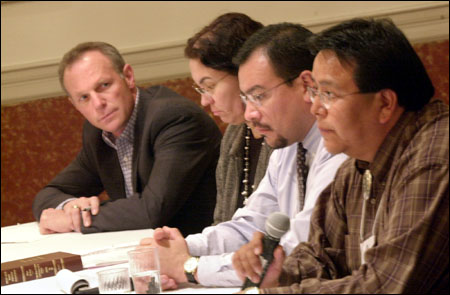Pros and cons of Native gaming eyed:
Symposium focuses on social, economic impact

Up until the 1980s, the San Manuel Band of Mission Indians of Highland, Calif., were dirt poor, with a 75 percent unemployment rate. The tiny tribe lived on a reservation of 740 acres in the San Bernardino hills, mostly in mud huts without electricity or running water.
Then they invested in a project known as the San Manuel Indian Bingo and Casino.
Today, in addition to the casino, the tribe owns, in whole or part: a hotel and an office building in Washington, D.C.; a broadband Internet provider; an industrial park; a bottled water business; and the popular Twin Palms Restaurant in Pasadena, Calif. Future projects include a shopping center and hotel complex, and a resort on Lake Havasu.

Deron Marquez, the tribe’s youthful chairman, listed these assets Tuesday (Jan. 7) with the suave self-assurance and understated humor of a person very much at home behind a microphone.
“It’s part of our investment strategy to bank land. It’s a smart thing to do in California,” he said with a nod toward the icy Cambridge streets. “Hey, right now it’s 82 degrees there!”
Marquez spoke as part of a symposium sponsored by the Harvard Project on American Indian Economic Development (HPAIED) titled “The Economic Diversification of Gaming Revenues by American Indian Nations.”
The symposium, which brought together dozens of tribal leaders from all over the United States, is part of a two-and-a-half-year project focusing on the social and economic impact of Indian gaming. There will be two more symposia over the course of this year plus 100 site visits to tribes with casinos. The project will culminate in a published report and a series of case studies.
Not every tribe that has elected to open a casino has been as successful as the San Manuel Band, pointed out Katherine Spilde, an anthropologist who is the project’s director.
“Tribal sovereignty means that tribes are free to make their own mistakes,” she said. “Just because you have capital to invest doesn’t mean you’re going to get it right every time.”
Location is also a crucial factor in whether a tribe is able to make gaming work for them. J. Kurt Luger, executive director of the Great Plains Indian Gaming Association, spoke about how some Midwestern Indian casinos have failed to produce much revenue because the reservations on which they are based are too far from population centers.
Other tribes, like the Gila River Indian Community of Phoenix are more geographically blessed.
“They’ve been in Arizona for 3,000 years, and now Phoenix just happens to surround them,” Spilde said.
The tribal group, now numbering about 19,000, owns three casinos, four golf courses, a four-star spa and resort, in addition to orchards, cotton farms, and cattle ranches.
As Spilde points out, many tribes that have profited from casinos are now anxious to diversify because they realize that Indian gaming is politically vulnerable.
“It’s fine that we have gaming, but we don’t know how long it’s going to be around,” said John McCoy, director of governmental affairs of the Tulalip Tribes of Washington state. “We have it, but they want it, and they’re going to take it away from us, so we have to diversify.”
In the meantime, however, it is clear that gaming is benefiting Indian tribes in a variety of ways. Anthony Miranda, president of the California-based Pechanga Development Corporation, said, “We’re all for education. If any of our members want to go to school to learn anything, we’ll make it possible for them to do it.”
According to Joseph Kalt, co-director of HPAIED, the diversification of gaming revenues among Indian tribes is already well under way.
“The range of activities they’re involved in goes against the media image of Indian casinos. They’re into everything from sewage treatment to high-tech manufacturing,” he said.
Kalt said that one of the aims of the project is to allow tribes to learn from one another, not only at conferences like this one, but from case studies and journal articles that will be available to tribal leaders.
Hopefully, that knowledge will help more tribes follow the example of the San Manuel Band and leverage their gaming revenues to achieve economic independence. The extent to which this transformation is already taking place is not yet clear to the public, Kalt said.
“There’s a real sea change going on, and for the most part the media just isn’t getting it.”




